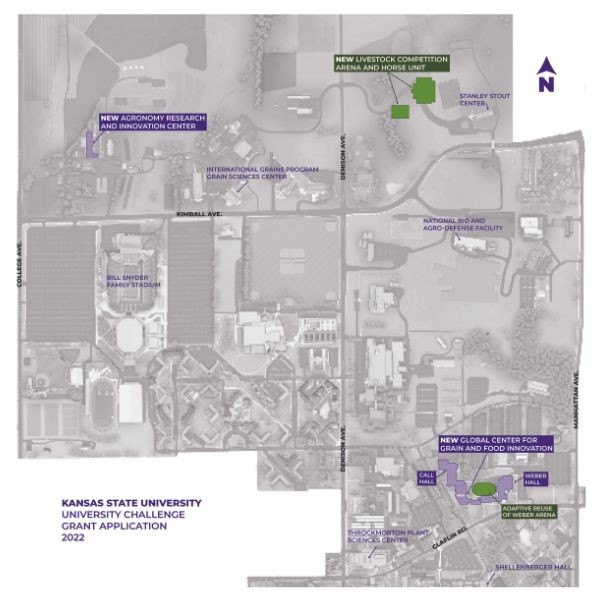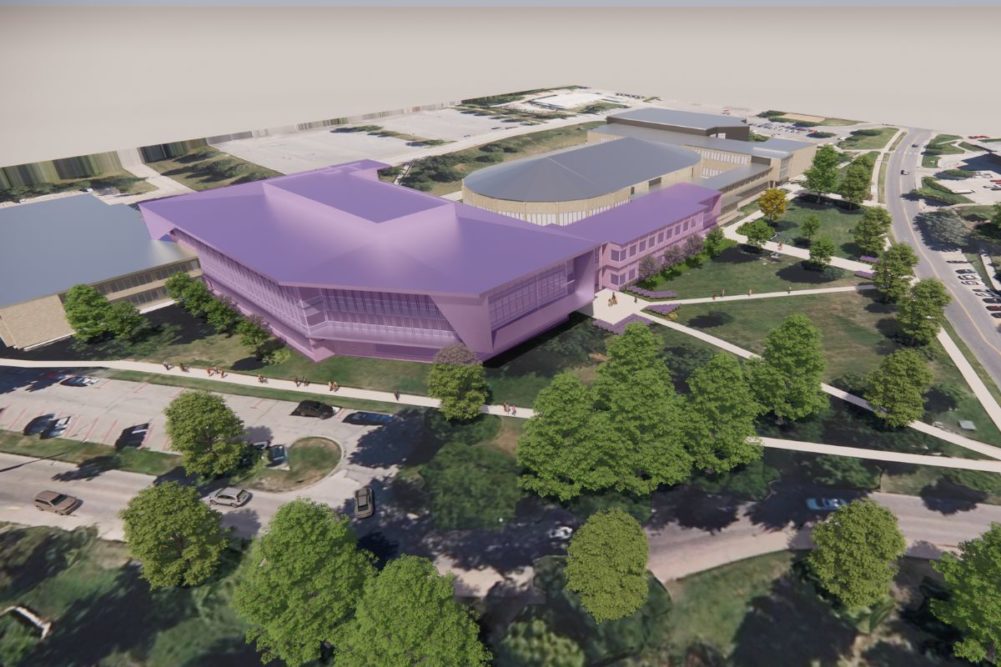MANHATTAN, KANSAS, US – Kansas State University (KSU) has raised $81.4 million for an infrastructure upgrade of several departments within the College of Agriculture, including the Department of Grain Science and Industry, university representatives said in a recent exclusive interview with editors from Sosland Publishing Co.
The initial money raised from contributions from private and corporate donors, as well as $50 million in pledged appropriations from the Kansas legislature, will allow KSU to begin phase one of the upgrade in the coming months. A second phase is expected to follow, but additional funds will need to be secured for that plan to come to fruition, said Ernie Minton, dean of KSU’s College of Agriculture and director of K-State Research and Extension.
The plan includes the deactivation and razing of Shellenberger Hall, which has been home to the Department of Grain Science and Industry since 1960, and the construction of a new building on the north side of campus, Minton said. Also part of phase one will be the construction of an agronomy center that will house the field research component of the Department of Agronomy, including the wheat breeding program, and renovations to the Department of Animal Science’s Weber Hall and Call Hall.
Kicking off the infrastructure project will be construction of the agronomy center, which Minton said should begin toward the end of this year and be completed in 2024. Construction of the new Global Grain and Food Innovation Center will follow soon thereafter.
“We have set ourselves up for what we hope to be a second-to-none student experience and continue the success we’ve had with research outreach and engagement,” Minton said.
Minton said the state legislature initially committed $25 million to the plan and pledged an additional $25 million as a 1-to-3 match if the university raised $75 million. Susan Metzger, associate director for agriculture and extension at KSU, said the donations raised by the university along with the money pledged from the state puts the overall total at about $125 million. But there is more fundraising to be done.
“The project is going to be a little over $200 million when it’s all said and done,” Metzger said. “We’ve made some great progress here.”
To achieve the $81 million in donations, Metzger said KSU received $51.1 million from individual donors, $11.5 million from ag and commodity stakeholders and organizations, $10 million from industry partners and $8.8 million from a land sale. That included a $5 million gift from the Kansas Farm Bureau and a $4 million donation by the Kansas Soybean Association and Commission, she said, noting that the university received numerous other significant donations but many of the donors wish to remain anonymous.
Minton said phase two of the project will include additional renovation to Weber Hall and Call Hall as well as the building of a state-of-the-art livestock competition arena on the north end of campus near Stanley Stout Center, another Animal Science facility.
Speaking to the North American Millers’ Association on Sept. 30, Kerry Wefald, senior director of development at the KSU Foundation, said that in an assessment of the College of Agriculture facilities conducted in 2019 by an outside consultant, none of the buildings graded higher than a D, and the feed technology building and Shellenberger Hall both received failing grades.
“We are a global program in grain science in a very unacceptable situation,” Wefald said.
Minton said several factors necessitated the plan to construct a new building to replace the aging Shellenberger facility. The first is that, like most buildings that were constructed more than six decades ago, it has become outdated, and its physical condition has deteriorated.
Hulya Dogan, interim head of the Department of Grain Science and Industry, noted that a massive water leak on Christmas Day caused significant damage to the building.
“In my 17 years here, I have never seen anything that bad,” she said. “This was major water damage. If people had been in the building at that time, someone could have gotten hurt.”
Equally concerning, Dogan said, was the impact the antiquated facility was having on the learning experience of current students and the ability to attract prospective students. Enrollment in milling science and management has fallen sharply, from a peak of 88 in 2017 to only 40 in the current school year. Bakery science and management also has fallen, from 88 in 2014 to 42 currently, and feed science and management, the Department’s third area of study, has declined from a peak of 51 in 2015 to only 15 students this year.
Plans to reverse these enrollment trends include engaging a full-time recruiter and having student mentors and ambassadors representing the Department of Grain Science and Industry. Having a new state-of-the-art facility to show prospective students and their parents is also part of the equation, Minton said.
Of Shellenberger Hall, Minton said: “We don’t have the look of an elite, worldwide department when you go into that building. It’s difficult to quantify the degree to which that provides disincentive to 18-year-olds and their families that come to visit. So, it’s getting out of that space that’s failing and doesn’t have the modern look — and to a certain degree equipment — that will be required for modern instruction and research.”
Given the 63-year history of Shellenberger Hall and the reverence for the man it’s named after — John Shellenberger, head of KSU’s Department of Flour and Feed Milling from 1944-66 — officials in the College of Agriculture are discussing how to honor Shellenberger in the new building.
“How the building will be named, given the other new donors, is a complexity that we’ll have to work through,” Minton said. “But we have an awareness of that sensitivity already from his family. We have to honor that and figure that out. We don’t know what that looks like yet exactly.”
 Although there was some discussion about constructing the new Department of Grain Science and Industry building at the same location where Shellenberger has stood, in the center of campus, officials ultimately decide to build on a site just north of Shellenberger, in the same vicinity as the Animal Science buildings, Call Hall and Weber Hall.
Although there was some discussion about constructing the new Department of Grain Science and Industry building at the same location where Shellenberger has stood, in the center of campus, officials ultimately decide to build on a site just north of Shellenberger, in the same vicinity as the Animal Science buildings, Call Hall and Weber Hall.
Meanwhile, the Agronomy Research and Innovation Center will be built to the west of the Grain Science Complex that includes the Hal Ross Flour Mill, O.H. Kruse Feed Mill, IGP Institute and other facilities. Minton said having these departments in roughly the same location would “remove barriers to interdisciplinary collaboration” that currently exist.
“It will remove the physical barriers that keep students who are majoring in different departments from interacting and studying alongside students in another discipline,” he said. “We think the real difficult problems that food and agriculture will be facing over the next two decades won’t be solved by any one discipline. It will be a multidisciplinary effort, and we think that’s true in this case as well.”
Because of the downward trend in enrollment across the various departments in the College of Agriculture, one of the stipulations for receiving state money is that the new buildings maintain the square footage of the current facilities. Minton said even with that constraint, the new buildings will be designed to maximize efficiency of space to benefit students.
“We have designed large-size classrooms that both animal science and grain science can utilize,” Minton said. “I think the initial design of the laboratories really open up collaboration with fewer walls, fewer doors, and lots of mixing of cereal sciences with others in a larger collective lab space, and in addition, that modernizes the facilities for pet food manufacturing as well.”
In addition to Weber Hall and Call Hall receiving much-needed renovation, the Department of Animal Science also is hoping to raise enough funds to build a world-class livestock arena that would replace the arena located next to Weber Hall.
Minton described the proposed facility as a “performance-size arena with 3,000-attendance seating that also has luxury boxes. It will have a full-plan parking lot with utility hookups and the kinds of things folks bringing livestock will need for that kind of event.”
If the plan for the new livestock arena is realized, the Department of Animal Sciences would be able to “strategically repurpose” Weber Arena for various uses.
The bottom line, Minton said, is that new facilities have a positive impact on current students and help attract prospective students. He pointed to new construction and renovation that has taken place in KSU’s College of Engineering, College of Architecture and College of Business programs.
“They’re frankly busting at the seams with new students,” he said.
“We just think that in some ways it could be regarded as dangerous not to improve our facilities from a reliability perspective and that it’s also essential to present our programs in the appropriate kind of modern facilities our students deserve,” he said.






